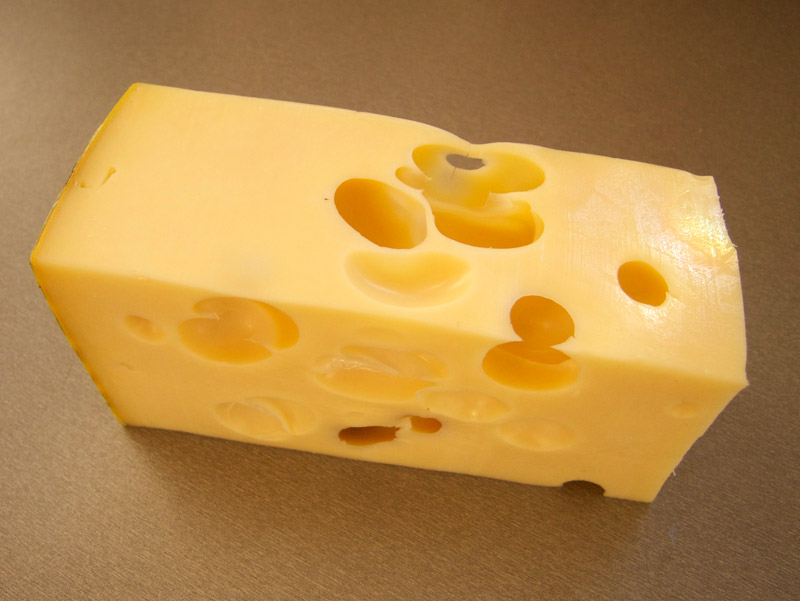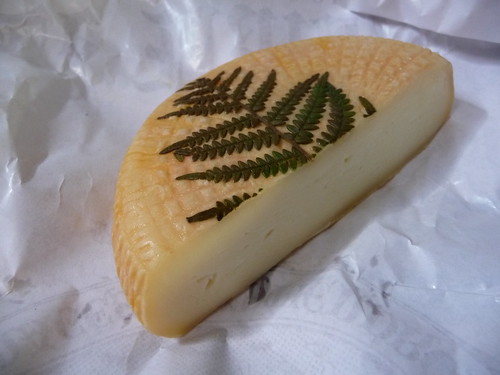-
Content Count
1456 -
Joined
-
Last visited
Posts posted by cheeseman
-
-
Good time to import some cheese!

-
Anyone seen any good cheese-related designs lately?
-
Sorry for the summer break but we can now get back to having regular updates to Cheeseman's Cheese of the Week post.
In recognition of pie-eaters fine work over summer in visiting Hawes and the Wensleydale factory, lets look at Wensleydale.
Wensleydale
Traditional, hard cheese made from cow's milk. It has a shape of cylinder with natural rind. Wensleydale can be used as table cheese and is very tasty with apple pie. This cheese is based on the recipe that can be traced back to the Cistercian monks who came over with William the Conqueror in the 11 century. There are two types of the British classic Wensleydale: White, a flat disc that is highly-pressed and has a honey flavor to it and Blue or Yorkshire, which has blue veins, double cream and is a cousin of Stilton - the blue variety comes in large drums. Good Wensleydale has a supple, crumbly, moist texture and resembles a young Caerphilly. The flavor suggests wild honey balanced with a fresh acidity. It matures in two to four months and has a fat content of 45 per cent.[/b]
Wallace and Gromit:
In the 1990s, sales had fallen so low that production was at risk of being suspended. However, the popular Wallace and Gromit animated shorts A Grand Day Out and A Close Shave had the main character Wallace, a cheese connoisseur, mention Wensleydale as a particularly favourite cheese. Animator Nick Park chose it solely because it had a good name that would be interesting to animate, unaware of the company's financial difficulties. The company contacted Aardman Animations about a licence for a special brand of "Wallace and Gromit Wensleydale", which proved to be an enormous success. When the 2005 full-length Wallace and Gromit film, Curse of the Were-Rabbit, was released, sales of Wensleydale cheeses jumped by 23%.



More from pie-eater
http://www.snowjapanforums.com/ubbthreads.php/topics/416590/5.html
-
Excellent reports pie-eat and Hawes is certainly a good place for Cheesefans. You must have had a particularly cheesy day!
-
I like Indian food, even if they don't really do cheese well at all.
-
Where should we go this week for Cheeseman's Cheese of the Week?
How about Holland!

Maasdam
Modern, creamery, semi-hard cheese made from cow's milk. It is boulder-shaped cheese. The smooth, natural rind is polished and may be waxed. The cheese was created in the early 1990's as an alternative to more expensive Swiss cheese Emmental. Although there are similarities with Emmental, it is higher in moisture and therefore, more supple. It ripens faster than other Dutch cheeses, being ready in four to 12 weeks. The flavor is sweet and buttery, with a fruity background, making it ideal for serving as a snack or breakfast cheese. It can also be grilled.


-
Good morning Cheesefans.
It's time for a new Cheeseman's Cheese of the Week. And this week we will go to Spain. Idiazabal. Nice smoky flavor.
Idiazabal
Traditional, farmhouse, unpasteurized, hard cheese. It has a shape of cylinder, with pale yellow to amber in color. The natural rind is smooth and hard. The cheese has a compact texture, with a few pinprick holes. It is dry, but not crumbly, and feels pleasantly oily in the mouth. The rind carries the marks of the wooden moulds in which it is drained. The characteristic, smoky flavor was originally the result of the cheeses having been stored near the shepherd's night fires. There were no chimneys in the simple mountain huts, so the cheeses absorbed the sweet, aromatic smoke.
--
Idiazabal is a pressed cheese made from unpasteurized sheep milk, usually from Latxa and Carranzana sheep in the Basque Country and Navarre, Spain. It has a somewhat smokey flavor, but is usually un-smoked.
The cheese is handmade and covered in a hard, dark brown, inedible rind. It is aged for a few months and develops a nutty, buttery flavour, eaten fresh, often with quince jam. If aged longer, it becomes firm, dry and sharp and can be used for grating.
The Denomination of Origin for Idiazabal cheese was created in 1987 and defines the basic regulations for the product's manufacture. Typically, unpasteurized milk from latxa breed of sheep is used, although in some cases the D.O. permits the use of milk from Carranzana breed, from the Encartaciones in Biscay. The D.O. also stipulates that the milk be curdled with the natural lamb rennet, and permits external smoking of the cheese. The cheeses produced in the following towns in accordance with all the D.O. regulations, are therefore also protected by the Idiazabal D.O. : Urbia, Entzia, Gorbea, Orduña, Urbasa and Aralar. Recently some Basque Country farmers have begun to use hybrid Assaf sheep, which some maintain does not meet the Denomination of Origin for the cheese.


-
Do other countries have such permits?
-
Hi folks. OK so here is the new Cheeseman's Cheese of the Week.
This week, France.
Only had this one a few times, but I did like it.
Filetta
Filetta comes from Isolaccio, which lies 45 km south of the town of Bastia. It means "the fern" in Corsican. It has a faint smell of the cellar and fern leaves and is decorated with a sprig of fern. The maturation period is three to four weeks. The fat content of Filetta is 45%. Filetta is made from ewe's or goat's milk.


-
Imposter!

No, I am Cheeseman. I will be posting a new Cheeseman's Cheese of the Week soon.

-
Hi Cheesefans, time for another Cheesemans Cheese of the Week!
Over to Germany
Allgauer Emmentaler
Traditional, creamery, hard cheese made from cow's milk. It has a wheel shape with smooth, waxed, natural rind. It is used as a table cheese, but is also good for melting and grilling. The cheese is sweet, fruity with holes of the size of walnuts. It is less expensive than the Swiss original.

-
Excellent. And me too. I hope it will be a normal season after all that has happened this time.
-
More cheese facilities would help encourage Cheesefans from around the world to visit Japan. Right now, Japan is still sadly lacking in this respect.
-
I hope they are going to be catering to all those Cheesefans as well. I have said before, but it's something that resorts are lacking and they really should take note of my ideas.
-
Hi Cheesefans, it's time for a new Cheeseman's Cheese of the Week. How about a trip to Italy this time...
Mascarpone
A soft, white, fresh, vegetarian, cream cheese from the Lombardy region of southern Italy. In fact, it is not cheese at all, but rather the result of a culture being added to the cream skimmed off the milk, used in the production of Parmesan. It is, however, described as a curd cheese, although it is made in much the same way as yogurt. To make Mascarporne cheese tartaric acid (natural vegetable acid derived from the seed of the tamarind tree) is needed. After the culture has been added, the cream is gently heated, then allowed to mature and thicken. This whitish to straw-yellow, creamy, mild fresh cheese is compact, but supple and spreadable and it is added to famous Italian desserts, sometimes accompanied by cognac. Frequently it is used for the preparation of certain dishes and sauces. It takes only a few days to ripen and has a fat content of 75 per cent.
Cheese or not a cheese? Whatever, I think it deserves a place

-
Thanks. Just posted a new Cheeseman's Cheese of the Week.
-
Hi Cheesefans
Sorry for the delay a bit of personal stuff. But we are back now and a new Cheeseman's Cheese of the Week!
Here's a nice one from England, Double Gloucester
Double Gloucester
It is a traditional, unpasteurized, semi-hard cheese which has been made in Gloucestershire since the sixteenth century. Records show, however, that Gloucester was known as early as the 8th century. The hard, natural rind has some gray-blue moulds and bears the marks of the cloth in which it is matured. Cheese merchant payed attention to rind's robustness. They used to jump on it with both feet to test it. If the rind didn't crack, the cheese was safe to travel. The full-cream, two milking sessions milk in Double Gloucester gives it characteristic, rich, buttery taste and flaky texture. It is firm and bitable, like hard chocolate. The color is pale tangerine. The cheese has a flavor of cheese and onions. Not as firm as Cheddar, it has a mellow, nutty character with an orange-zest tang.

-
Thank you folks.
We are starting to get back to normal now.
I hope to get the Cheeseman's Cheese of the Week thread back up and running this week.

-
Thank you.
It has been a difficult time, though we're not the only ones going through difficult times right now of course.
-
So sad to see all this happen.

We were out of Japan at a good time it seems. (Had to be away because of family passing away).
-
Appreciate all the wonderful work guys.
Sorry I haven't posted, we had to go back to our home as Cheesewoman's mother passed away and so it has been a difficult and busy few months.
Sorry for the lack of many Cheeseman's Cheese of the Week as well.
I will be back, no worries.

-
Hi Cheesefans

It's time for a new Cheeseman's Cheese of the Week!
This week over to Denmark for a nice tasty cheese
Orla
Orla is a modern, farmhouse, unpasteurized, organic, vegetarian, semi-hard cheese made from sheep's milk. It has a round shape with fine, orange, brine-washed crust. It is one of the cheeses that belongs among semi-soft and hard, depending on the degree of maturity. Orla is supple and decidedly semi-soft when young. After being aged in cellars for up to six months, it resembles Manchego in texture, although it is less oily. The mature cheese is sharp and salty, while retaining the burnt-sugar flavor so typical of sheep's milk. Orla is matured for 2-6 months.

-
I'm going to be able to post some of my own soon.
Top work Cheesefans!

-
Wonderful just wonderful.




Cheesemans "Cheese of the Week"
in General off-topic discussions
Posted
Hi Cheesefans, time for another Cheeseman's Cheese of the Week!
How's about this one from France.
Baguette Laonnaise
Traditional, creamery, washed-rind cheese made from cow's milk in industrial city of Laon. It has a shape of loaf or brick with glossy but crusty, orange-brown rind. The cheese was created after WW2. The sticky, ridged, orange-brown rind hides a supple, yet dense interior. As the cheese ages, it develops a very pungent, spicy taste, and a finish that is reminiscent of the farmyard. In the cold fridge the rind may dry out and the cheese will become quite bitter and unpleasant to eat. Affinage takes two months.